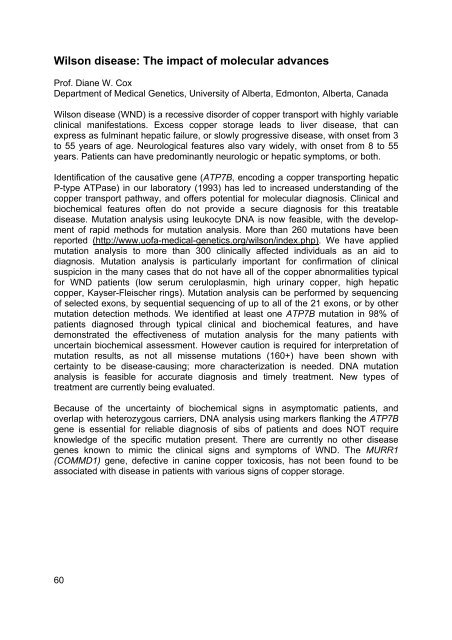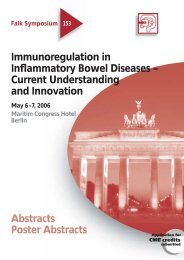Abstracts Poster Abstracts - Dr Falk
Abstracts Poster Abstracts - Dr Falk
Abstracts Poster Abstracts - Dr Falk
Create successful ePaper yourself
Turn your PDF publications into a flip-book with our unique Google optimized e-Paper software.
Wilson disease: The impact of molecular advancesProf. Diane W. CoxDepartment of Medical Genetics, University of Alberta, Edmonton, Alberta, CanadaWilson disease (WND) is a recessive disorder of copper transport with highly variableclinical manifestations. Excess copper storage leads to liver disease, that canexpress as fulminant hepatic failure, or slowly progressive disease, with onset from 3to 55 years of age. Neurological features also vary widely, with onset from 8 to 55years. Patients can have predominantly neurologic or hepatic symptoms, or both.Identification of the causative gene (ATP7B, encoding a copper transporting hepaticP-type ATPase) in our laboratory (1993) has led to increased understanding of thecopper transport pathway, and offers potential for molecular diagnosis. Clinical andbiochemical features often do not provide a secure diagnosis for this treatabledisease. Mutation analysis using leukocyte DNA is now feasible, with the developmentof rapid methods for mutation analysis. More than 260 mutations have beenreported (http://www.uofa-medical-genetics.org/wilson/index.php). We have appliedmutation analysis to more than 300 clinically affected individuals as an aid todiagnosis. Mutation analysis is particularly important for confirmation of clinicalsuspicion in the many cases that do not have all of the copper abnormalities typicalfor WND patients (low serum ceruloplasmin, high urinary copper, high hepaticcopper, Kayser-Fleischer rings). Mutation analysis can be performed by sequencingof selected exons, by sequential sequencing of up to all of the 21 exons, or by othermutation detection methods. We identified at least one ATP7B mutation in 98% ofpatients diagnosed through typical clinical and biochemical features, and havedemonstrated the effectiveness of mutation analysis for the many patients withuncertain biochemical assessment. However caution is required for interpretation ofmutation results, as not all missense mutations (160+) have been shown withcertainty to be disease-causing; more characterization is needed. DNA mutationanalysis is feasible for accurate diagnosis and timely treatment. New types oftreatment are currently being evaluated.Because of the uncertainty of biochemical signs in asymptomatic patients, andoverlap with heterozygous carriers, DNA analysis using markers flanking the ATP7Bgene is essential for reliable diagnosis of sibs of patients and does NOT requireknowledge of the specific mutation present. There are currently no other diseasegenes known to mimic the clinical signs and symptoms of WND. The MURR1(COMMD1) gene, defective in canine copper toxicosis, has not been found to beassociated with disease in patients with various signs of copper storage.60



